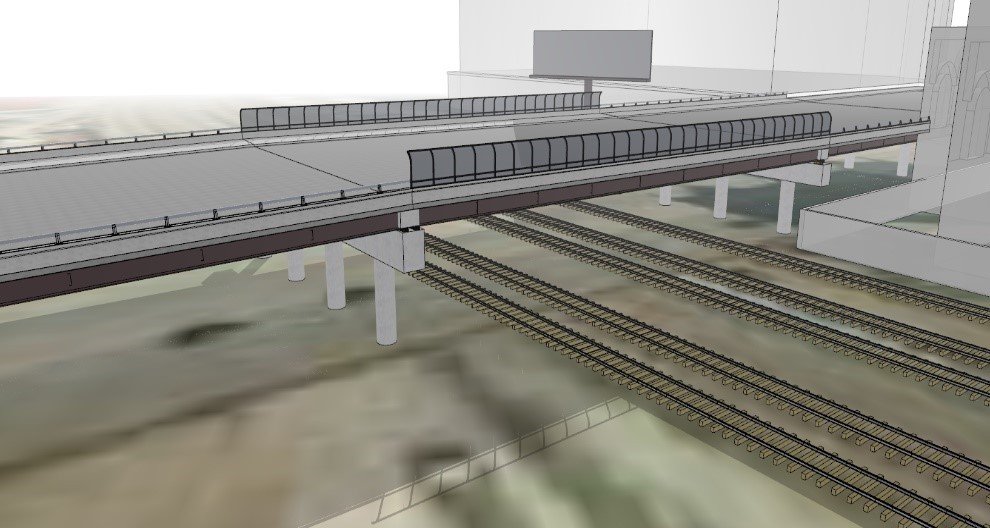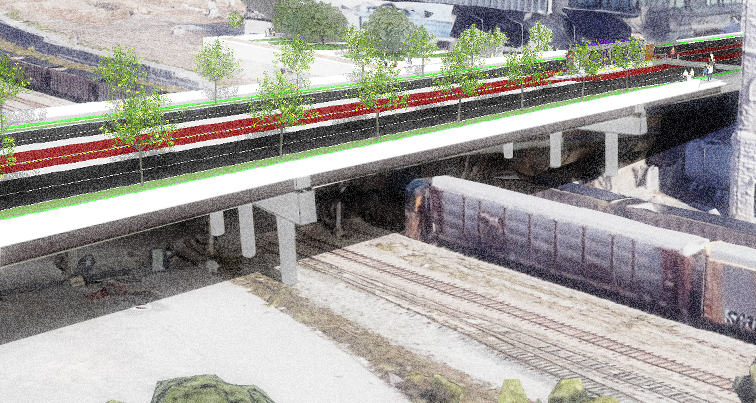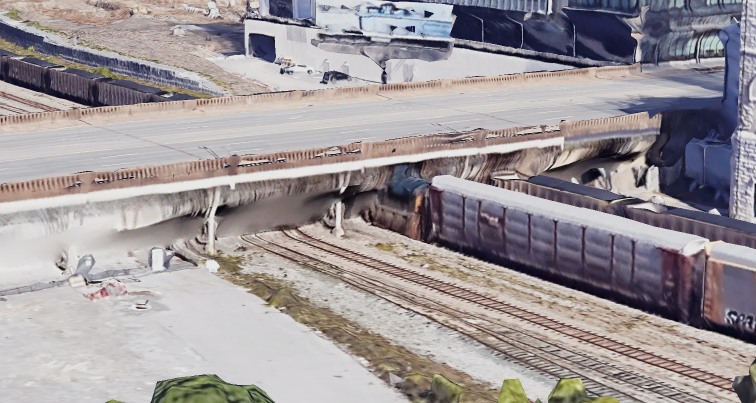From highway to gateway: Broadway bridge makeover
Written by Veronica Foster, Communications + Advocacy Manager
Visions by Eric Hoke, Design Director
Image showing potential for a new Broadway Bridge and its connection to Union Station and the Nashville Yards’ public space
The Broadway Bridge over the Gulch has reached the end of its lifespan. Like all road and highway maintenance, sometimes an entire stretch needs to be repaved, but repaving cannot repair structural wear and tear. So, the bridge has to come down and be rebuilt.
Tennessee Department of Transportation (TDOT) calls the Broadway Bridge a “Gateway Bridge,” which really has them focused on the importance of rapid construction and traffic mitigation over design innovation or improvements. Kiewit was selected as the Construction Manager-General Contractor (CMGC) to work through issues and maintain pace as the bridge was redesigned by Gresham Smith. It seems as though the bridge has so far mostly been “reengineered” as a mirror structure to what exists today.



In a Metro Council Joint TDOT + Nashville Department of Transportation and Multimodal Infrastructure (NDOT) Committee Presentation where the project was introduced on November 15, 2022, TDOT explains that they have mainly been working with “primary stakeholders” directly surrounding the bridge like M Street, Union Station, Highwoods, and other businesses in the larger footprint like the Nashville Chamber, Downtown Partnership, and businesses in the Gulch. This was regarding both community information and design “aesthetic,” where they hope to “complement the area and not compete with the area.” Council Member Gamble and Bradford asked about improvements to the bridge from lighting to bike lanes, but they were not given any concrete responses.
This opportunity only comes once every 70 years
Back in 2005, Nashville was experiencing this same conundrum with the Demonbreun Bridge one street over from Broadway. Their intention was to rebuild the bridge with the exact same design, but the Civic Design Center was vocal about adding more pedestrian-forward improvements to both the deck and the underside of the bridge. We encouraged them to redo their entire engagement process. Due to our experience with this type of work, we have requested to be considered a stakeholder to speak up for future considerations.
Tennesseean clippings from 2005
We agree with Council Member Swope that if this bridge is to truly represent a “Gateway” to our city, it should have a greater architectural aesthetic. However, it should also have a functional design that represents our priorities for multimodal transportation. When Council Member Henderson asked about the considerations for multimodal transportation including the opportunity for bus rapid transit in this corridor, NDOT explained that they were advocating for a 14-foot multi-use path with TDOT. However, TDOT focused on how the footprint of the bridge cannot be expanded, so while there would be 10-foot sidewalks, bike lanes or transit lanes didn’t seem like a priority. Therefore, the current design demonstrates 3 travel lanes in each direction and a multi-use lane in the center much like the bridge today.
In 20 years, Downtown Nashville has become a brand new neighborhood. We can’t lose the opportunity to create something that will be effective for our city 10-20 years from now when we won’t have another opportunity to replace it for 70 more years. That means prioritizing more sustainable transportation in the built infrastructure.
Building the case for a road diet
What is a Road Diet?
A Road Diet is a street re-striping project that can remove travel lanes or reduce lane width in the right-of-way. The FHWA shares that its purpose is, “to better meet the needs of all road users.”
Road diets can reduce vehicle speeds and crashes while also returning a large portion of the street to other forms of transportation, creating new areas for dedicated transit lanes, bike lanes, or larger sidewalks.
Do we really need 6 travel lanes and a turn lane on this bridge?
Data from 2021 for the Broadway Bridge shows a traffic count of 22,304 vehicles per day on average. This comes from TDOT’s public traffic counts located on Broadway between the 10th and 11th. As you can see, the traffic count trends have decreased significantly in the last 5 years. This could mean that people noticed a significant traffic pattern and have chosen other routes, or they have chosen other methods of transportation. Regardless of how we got here, 22,000 is on the cusp of where the FHWA recommends a traffic study to evaluate the feasibility of a road diet.
AADT = Annual Average Daily Traffic on Broadway Between 10th and 11th
While the Broadway Bridge is a state road, we know this is a partner project with both TDOT and NDOT. NDOT has put forth a statement that they are in the process of “develop a modernized [Traffic Impact Study] guideline with associated Code changes (if necessary) to align with the Nashville Department of Transportation’s mobility goals and account for the diversity of modal split, the intensity of development, and current best practices.” We hope this means that they are reworking the guidelines for traffic studies to recommend greater right-of-way for sidewalks, bike lanes, and bus rapid transit. Knowing Broadway is in the Vision Zero High Injury Network, and a transit priority corridor in Nashville Next (Nmotion), changes need to be considered that prioritize our most vulnerable pedestrians.
The “Blue H” image on page 14 in nMotion (the adopted transit planning document for Metro Nashville).
As Council Member Henderson’s reaction might convey from the project presentation, 6 travel lanes and 1 multi-use turn lane seem excessive and we agree. Traffic counts are decreasing, and could continue to decrease if we offer safer multimodal options to get to and from Downtown.
TDOT’s Section Proposal Broadway BridgeThis image shows a proposal for TDOT’s typical section of the new Broadway Bridge. Streetmix.net estimates that the a road with this type of section will average traffic of 39,000 people per hour, and the potential for up to 42,000 people per hour.
Graph showing traffic volumes of TDOT’s proposed Broadway bridge design. Source: Passenger capacity of different transport modes, Transformative Urban Mobility Initiative (TUMI)
Civic Design Center’s Section Proposal Broadway BridgeThis image shows a Civic Design Center proposal for a typical section of the Broadway Bridge. Streetmix.net estimates that the a road with this type of section will average traffic of 88,000 people per hour, and the potential for up to 110,000 people per hour.
Graph showing traffic volumes of Civic Design Center’s proposed Broadway bridge design. Source: Passenger capacity of different transport modes, Transformative Urban Mobility Initiative (TUMI)
Let’s find a way to make it beautiful
Image showing Civic Desing Center’s vision for a proposed bus rapid transit stop on the east side of the broadway bridge.
Council Member Freddie O’Connell shared a lot about the Broadway Bridge in his newsletter on December 6th, directing his constituents to learn about this fairly closed-door process that has been underway. He says, “this bridge is almost literally the gateway to downtown from the west. It should be a showpiece of infrastructure, especially coming at a time when we have a generational opportunity through the Infrastructure Investment and Jobs Act. Other cities are transforming themselves. They're finding ways to use infrastructure to help their residents live healthier, happier, less expensive lives. We are staying stuck in the past.”
Plan view looking at how the new bridge could interact with Union Station and Nashville Yards.
This is so much more than a Downtown bridge replacement. It is, as TDOT claims, “a Gateway Bridge.” We need to be thinking about its future because its existence will outlive so many people driving on it today.
Here’s what we can do:
Send a note to Rebekah Hammonds and Shane Hester on the project team for TDOT.
Ask for the Broadway Bridge to implement a road diet on the design giving right-of-way to protected bike lanes, and dedicated transit lanes. You can include an image of our visions in your email. You might also ask for a bridge design that represents the community’s identity celebrating the railroad gulch and with signage to say you are now entering Downtown Nashville. Let’s make this something to remember. As Council Member O’Connell said, “let’s build a bridge we love.”





